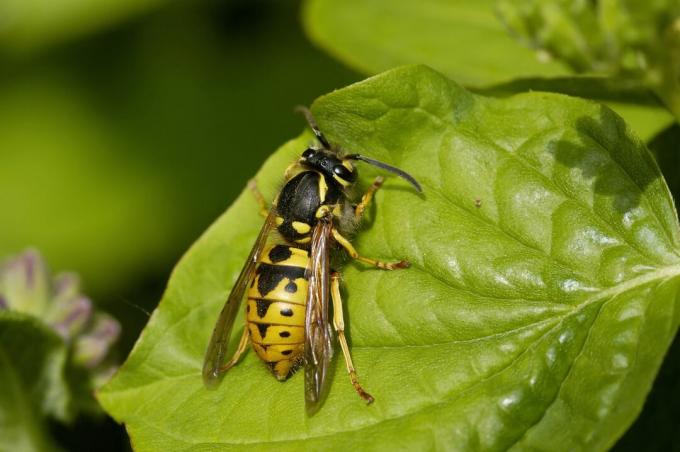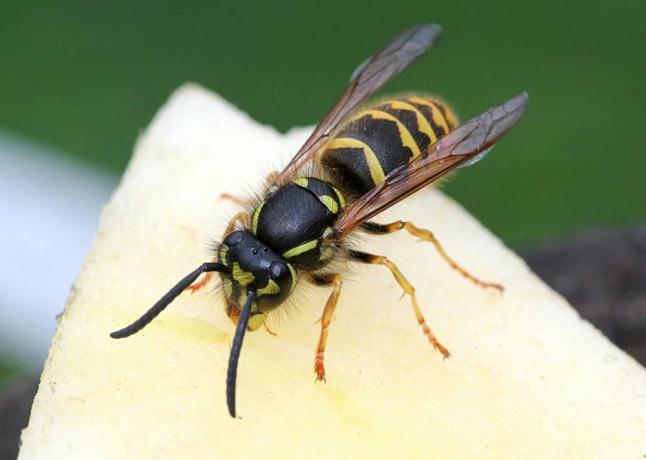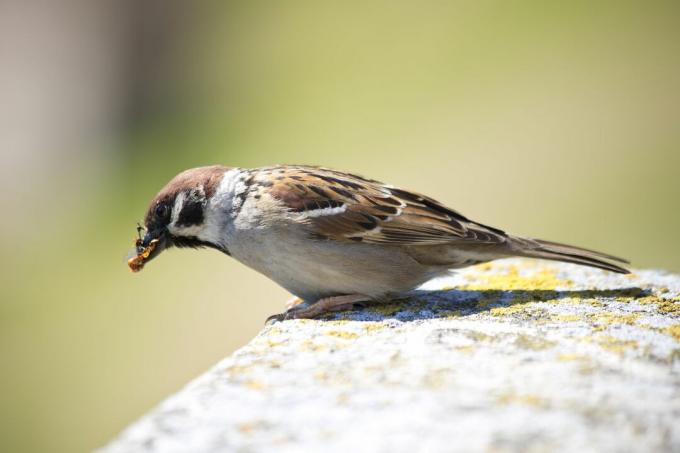Wasps may be killed and their nest removed under certain circumstances: nature conservation stipulates strict rules for this - you can find out more about this here.

In Germany, wasps are clearly one of those insects that everyone would like to do without in summer. The nerve-wracking beasts enrich themselves unrestrainedly in desserts and meat and they especially like to sting for no reason. In this article we want to clarify whether this bad reputation is really true. In addition, fighting the wasps is not that easy, because the animals are under special protection. Like all living things, they naturally also fulfill important functions in our ecosystem. There are also better ways to get rid of the wasps - without killing them straight away.
contents
- Recognize wasps
- Fighting wasps: allowed to drive away or kill?
- Wasp traps: allowed or forbidden?
-
Detect and remove wasp nest
- Recognize wasp nest
- Remove wasp nest
Recognize wasps
The real wasps (Vespinae) comprise an impressive 61 species worldwide. In Germany, however, there are only two wasp species that can really get on your nerves, at least seasonally. These pests are the common wasp (Vespula vulgaris) and the German Wasp (Vespula germanica). However, the German Wasp is considered to be a little less aggressive. Both species approach humans without much fear and can therefore occasionally cause problems. Most other species of wasps stay away from humans and would never think of looking at a table set with sweet foods and meat as a source of nutrition. The two aggressive wasp species mentioned are very difficult to tell apart, as the only distinguishing features are small details in the head area. In general, however, a distinction is not necessary either. Only the distinction to the other peaceful wasp species will be important again later in the section "Remove wasp nest".

The workers of the Germans and the Common Wasp are on average about 13-14 mm long and have the typical yellow-black striped warning colors on their bodies. In addition to the coloration, the waist of wasps is a sure way of distinguishing them from bees. All real wasps have a so-called wasp waist. This is a very narrow connection between the abdomen and the front body, as can be seen very clearly in the picture below. Bees do not have a wasp waist, and other insects that mimic wasps have wider waistlines. Animals that mimic the appearance of dangerous animals to protect themselves from predators are called mimicry. In relation to the wasp, this is, for example, the completely harmless hover fly or the longhorn beetle.

Fighting wasps: allowed to drive away or kill?
Before you even think about driving away, killing, controlling or relocating wasps, you should bear in mind that wasps are consistently protected. It is generally forbidden to kill wasps. Violation can be punished with heavy fines. In addition to the legal situation that is not always clear, which we will talk about shortly, wasps also have a high ecological benefit. On the one hand, they destroy a large number of harmful insects and are therefore also beneficial insects. On the other hand, they also serve as an important source of food for many birds and for that reason alone are very worthy of protection. Especially when you consider the sharp decline in bird biodiversity.

Regarding the legal situation, it should be said that wasps may only be fought if there is a justified danger. This is the case, for example, in people who are allergic to wasp stings. It is not entirely clear what the justified danger looks like in non-allergic people. The mere presence of a wasp should not be a valid reason to kill a wasp.
Wasp traps: allowed or forbidden?
In addition to control, catching wasps with wasp traps is also prohibited. It does not matter whether the wasp trap was built or purchased. Finally, it should be said again that wasps do not attack for no reason and with careful behavior there should also be no reason to have to fight or kill wasps. You should only exercise caution in the direct vicinity of a wasp's nest. Wasps will always defend their nest and painful stings can result.
Detect and remove wasp nest
Sometimes it can happen that the wasp queen has chosen your balcony or garden as a building site for her nest. Then it must be carefully considered whether you can come to terms with the nest for a summer or whether it needs to be disposed of. For the consideration it is important to take a closer look at the location of the nest and the nest itself.

Attention: At this point we would like to point out that you should always keep a distance of at least 3 meters from the nest. The common wasp and the German wasp in particular can otherwise react relatively aggressively and sting more often. The aggressiveness of the wasps is greatly increased by vibrations, hectic movements and by touching the nest. However, if these rules of conduct are followed, staying near the nest should not be a problem.
Recognize wasp nest
The nest itself can reveal a lot about the wasp species that live there. In the case of the German Wasp and the Common Wasp, the nest should be relatively large later in the season. In addition, the nest of the two species shows typical semicircular air pockets, while many others More peaceful wasp species have smaller nests, the outer shell of which also often has striated air pockets own. If the nest is freely hanging in a hedge or generally not in the dark, then it is also very likely that it is a peaceful wasp species. If the entrance hole is directly below in the nest, it is very likely that it is a hornet's nest. By the way, hornets also belong to the real wasps. After this assessment, you should be able to roughly estimate whether it is a more peaceful or more aggressive species of wasp.

The time of year also plays a role in determining whether the wasp's nest should be removed. In late summer, control is usually no longer worthwhile because the wasp state will be disbanded in some time anyway. After that, the wandering workers can strain your nerves for a short time, until the first frost. They fly around aimlessly in search of food, but they also spread over a large area. Fighting the wasp's nest doesn't help at this point either.
Remove wasp nest
If nothing really works anymore and there is a direct threat to you or other people, action should be taken. The first thing you need to do is get a permit from the responsible nature conservation agency so that the nest can be removed. We do not recommend relocating or fighting the nest yourself. You can put yourself at serious risk when fighting a large wasp state, as many wasp stings and stings in the neck region can be quite dangerous.

Errors can also be made during resettlement, which is why the Wasp State may die. It is therefore advisable to ask surrounding nature conservation organizations and beekeepers whether they can take care of the removal of the nest. Here you are usually made cheaper offers than with a professional pest controller. The specialist usually has to decide on site whether a nest can be relocated or whether it only makes sense to combat it. Of course, resettlement and thus the preservation of the wasp state is always preferable to control.
Did you know that there are some plants that can scare away wasps? In our special article you will find useful information about Plants against wasps.
